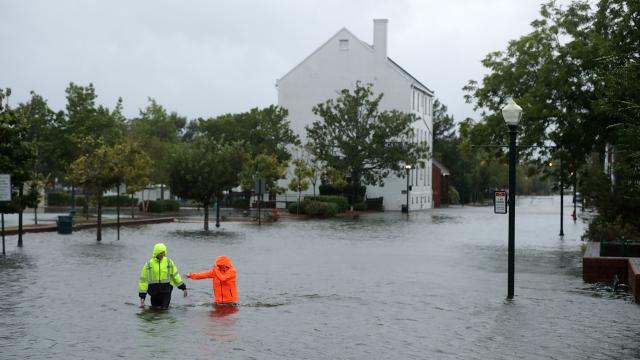The world is warming. There’s no longer any doubt of that. With a new report breaking down exactly how screwed we are, it’s time to back up and talk about the basics of the situation we’re in.
Why is the world getting warmer?
Because there’s a lot more carbon dioxide in the atmosphere than there ever used to be. Carbon dioxide is one of the “greenhouse gases” that trap heat on the Earth’s surface. (There are others, such as methane, but carbon dioxide is the biggest one at play when we talk about climate change.) NASA has a nice explainer on this here.
There are natural as well as human-made sources of carbon dioxide, but it’s the human-made ones that have been increasing over the years. We release carbon dioxide into the atmosphere when we burn fossil fuels. That includes driving cars (petrol is a fossil fuel) and using electricity that comes from coal-fired power plants (coal is a fossil fuel too), to name just a few.
Are we sure though?
Scientists agree: Just about every type of measurement, from today’s weather stations, to historical records, to layers of ice trapped thousands of years ago, all point to a drastic increase in carbon dioxide in the past 150 years or so, accompanied by an increase in temperature.
But we’re just talking about a few degrees, right?
The Earth has already warmed about 1C since we started burning massive amounts of fossil fuels. Countries that signed the Paris agreement are trying to keep warming below 2C. A few degrees, on a global level, is a lot.
What if I like warm weather?
This isn’t about you. If you like California’s climate better than New York’s, you can live in California and New York will still exist. As the Earth warms, cooler places and seasons will not be around any more.
There are the little things: More mosquitoes (including disease-carrying ones), less maple syrup, possibly no more coral reefs.
And the big things: More hurricanes, less ice in our ice caps, rising sea levels. We’re up 20cm already.
How inevitable is this?
That’s what scientists discussed in a report released this week, and it doesn’t look good. The Intergovernmental Panel on Climate Change produced the report for Paris agreement countries, and it says we’re on track for 3C of warming.
The good news (not really) is that if we stopped burning fossil fuels right now, we could keep warming under 1.5C. Theoretically — we are being optimistic here — we could also stay under 1.5C of warming if we dramatically slow down the rate at which we burn fossil fuels, and do our best to also remove carbon from the atmosphere.
But that would require a technological about-face that kinda doesn’t look like it will ever occur. As one scientist told The Washington Post:
“Even if it is technically possible, without aligning the technical, political and social aspects of feasibility, it is not going to happen,” added Glen Peters, research director of the Center for International Climate Research in Oslo. “To limit warming below 1.5C, or 2C for that matter, requires all countries and all sectors to act.”
This scenario only gives us 10 to 14 years of our current level of emissions, and would probably involve hefty carbon taxes to put the brakes on our spewing of carbon dioxide into the atmosphere.
OK, but what if I recycle?
If you want to reduce your personal carbon footprint, the highest-impact things you can do are to have fewer children, ditch your car, fly less, and become a vegan. But this is a bigger picture thing than what we can handle as individuals, so lobby your representatives to enact sweeping changes that affect our total, global carbon footprint.
Politically, there’s room for argument over what we should do about this situation, including the responsibility of high-income versus low-income nations. But scientifically, there’s no doubt that the Earth is warming and that it will require almost a superhuman effort to reverse that trend. Here’s wishing us luck.

Comments
4 responses to “The Dummies’ Guide To Climate Change”
Something I read years ago was that one of the biggest sources of greenhouse gases is cow farts. Yes you read that right, cow farts. Whether that’s true or not doesn’t really matter, but it raises an interesting question.
The amount of cows out there means the methane or CO2 (cant remember which it is) being produced is higher than its ever been. Those cows are being bred by us, for us. Humans.
So are those cow farts a natural or human made source? If it wasn’t for us breeding them, there wouldn’t be as many, so it seems pretty clear we’ve played a role. But they aint cars or factories. So how would that be considered?
If they’re being bred for human consumption they’d be considered man made. The article points out that one of the best ways to reduce personal emissions is to stop consuming animal products
In New Zealand agriculture accounts for almost half of total emissions, most of which is methane from cows and sheep
If they’re being bred for human consumption they’d be considered man made. The article points out that one of the best ways to reduce personal emissions is to stop consuming animal products
In New Zealand agriculture accounts for almost half of total emissions, most of which is methane from cows and sheep
If they’re being bred for human consumption they’d be considered man made. The article points out that one of the best ways to reduce personal emissions is to stop consuming animal products
In New Zealand agriculture accounts for almost half of total emissions, most of which is methane from cows and sheep